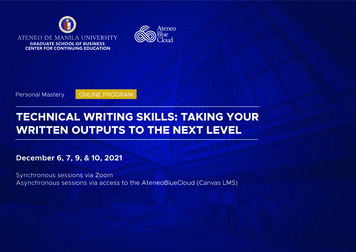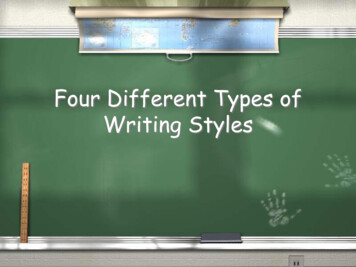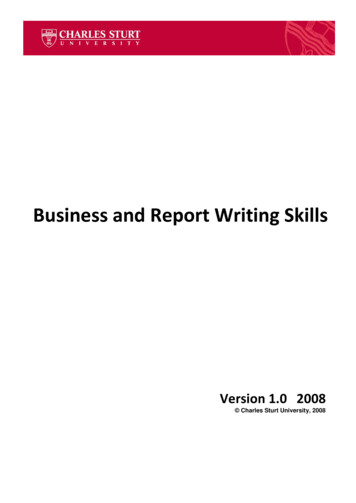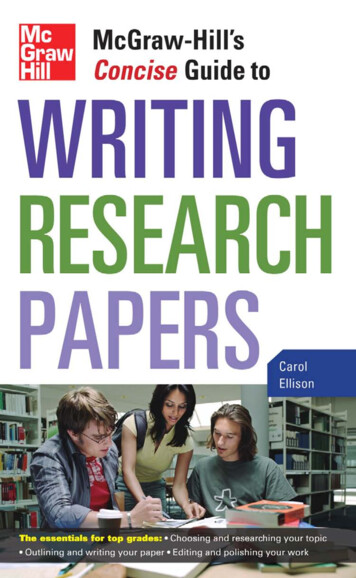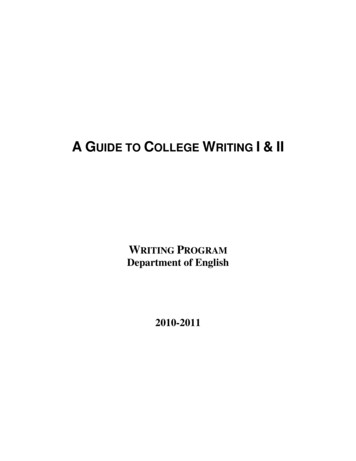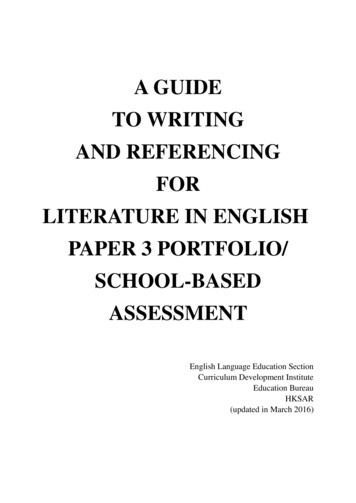
Transcription
A GUIDETO WRITINGAND REFERENCINGFORLITERATURE IN ENGLISHPAPER 3 PORTFOLIO/SCHOOL-BASEDASSESSMENTEnglish Language Education SectionCurriculum Development InstituteEducation BureauHKSAR(updated in March 2016)
ContentsPREFACEACKNOWLEDGEMENTSPART ONE1. Writing for the Literature in English Paper 3 Portfolio/School-based Assessment (SBA)2. Preparing for the Writing3. Structure of the Writing4. Presentation of the Writing5. Referencing of Sources of Information6. Plagiarism7. Final Checklistiii1122445PART TWO1. Introduction - General Rule of Citation2. Books3. Edited Books and Translation4. Articles in a Reference Book5. Essays or Articles in a Collection or Anthology6. Separate Works by the Same Author7. Journals, Magazines and Newspapers8. Editorials9. Reviews10. Materials from Electronic, Online Resources11. Government Documents12. Dissertations13. Abstracts14. Radio and Television Programmes15. Interviews16. Lectures17. Songs, Lyrics, Liner Notes18. Verse and Drama19. Brochures and Pamphlets20. Audio-Visual Materials and Films67101112121315161621212222232425252626Further Reference26
PrefaceThis Guide was jointly prepared by the Hong Kong Examinations Authority andThe English Section, Education Department in 2001 and updated by the EnglishLanguage Education Section, Education Bureau in 2016. The Guide is designedand developed in support of the Literature in English Curriculum and AssessmentGuide (Secondary 4-6) (updated in December 2015). It aims to provide guidelinesfor teachers to: advise students on the development of a research paper for thePortfolio/School-based Assessment component of the Literature in Englishpublic assessment; heighten students’ awareness of the importance of acknowledging the sourcesof information to avoid plagiarism; and introduce proper citation methods for different types of materials.This Guide comprises two parts. Part One contains some general tips on writingfor the Literature in English Paper 3 Portfolio/School-based Assessment (SBA).Part Two provides detailed explanation and examples on how to cite differenttypes of materials and sources of information using the Modern LanguageAssociation (MLA) citation style. Teachers might select and adapt the materials inthe Guide and draw students’ attention to relevant parts based on their needs.It should be noted that the MLA style of documentation is adopted in this Guidebecause it is widely used in the field of literary studies. However, teachers mayfeel free to introduce to students other citation formats, for example, theAmerican Psychological Association (APA) style, which is commonly used in thefields of social sciences and education. Different referencing styles are acceptedin the Portfolio/SBA for Literature in English so long as one style is consistentlyadopted throughout the entire paper.i
AcknowledgementsThe content in Part Two of this Guide is adapted from information on thefollowing shtmlThanks are due to Capital Community College, Hartford, Connecticut, USA, forpermission to reproduce part of their “A Guide for Writing Research PapersBased on Modern Language Association (MLA) Documentation”. The copyrightof the materials in Part Two of this Guide belongs to Capital Community College,Hartford, Connecticut, USA.Duplication of materials in this Guide is restricted to non-profit makingeducational purposes only. Otherwise, no material in Part Two of this Guide maybe reproduced, stored in a retrieval system, or transmitted in any form or by anymeans without the prior permission of Capital Community College, Hartford,Connecticut, USA.ii
PART ONE1. Writing for the Literature in English Paper 3 Portfolio/School-basedAssessment (SBA) (All schools will implement SBA starting from S4 in the2016/17 school year.)The paper/writing is related to, but not exclusively or extensively based on, the set texts forstudy.Students may want to: investigate a viewpoint/idea and discuss how far they agree with it; present a point of view with textual support and persuade the reader of its value; analyse and criticise the chosen text(s); compare and contrast different texts or different interpretations on the chosen text(s); identify an issue/topic and discuss how it is dealt with or presented in the chosen text(s); create an original piece of writing of a particular genre in response to a text/some texts; or give a critical review of a film/book/drama seen/read.2. Preparing for the WritingTeachers may remind students of the following before writing the paper: Decide on the purpose of the paper. Think it out clearly and then write it down in onesentence: “This paper is intended to analyse/describe/discuss/evaluate (the chosen topic)”.Pinpoint exactly the objectives and focus of the paper. Read widely and take notes. Read intelligently – do not waste time reading irrelevantmaterials. General and specialised books on a subject, journals, newspapers, magazines,government publications and films, reference materials in the forms of electronic or onlineversions may be consulted. Note down the title, the author/director/organisation that provides the materials and othernecessary details (such as the publisher, and place and year of publication) for inclusion inthe bibliography.1
3. Structure of the Writing (mainly relevant to analytical essays)Draw students’ attention to the different parts of writing and the purposes they serve:Introduction State the topic and purpose of writingState the main idea/central argument Give a brief outline of the main points to be covered to support themain idea/central argument BodyDevelop the main points Give information and evidence to support each point made to ensurethat each point is relevant to the topic and the argument is developedclearly and logically ConclusionSum up the main points Avoid introducing any new ideas or claiming to have shown/provedmore than the evidence can support4. Presentation of the WritingTeachers are encouraged to go through the following with students to prepare them for theirwriting: AudienceIt is important to always keep the audience (i.e. the reader and assessor) in mind whenwriting an essay or review. Students should be made aware of the reader’s priorities andbackground knowledge to ensure the points are made clearly, concisely and convincingly.The use of “I”, “me”, “we”, “you”, “our” etc. should be avoided as it makes the work seemsubjective rather than objective. On the whole, students should also be reminded to avoidusing terms such as “In my opinion”, “I think that ”, “It is my belief that ”, and shoulddevelop the habit of writing in the third person. However, there are circumstances thatrequire students to express personal views or relate the literary texts to their personalexperience. ToneTone is the combination of two things: namely, the attitude the writer has towards thesubject and the attitude the writer has towards the audience.In general, the tone of writing should be objective and persuasive. Students should beadvised not to allow emotional outbursts to detract the audience from the work. Inargumentative essays, any fallacies that may weaken the logic and coherence of the2
argument should be avoided. LanguageStudents should be encouraged to aim for simplicity of language and straightforwardexpressions. Most readers prefer plain English, which conveys meaning precisely, clearlyand in uncluttered fashion. It is not advisable to use words just because they “sound”impressive.Colloquialisms and slang should also be avoided. There is a difference between written andspoken English. The distinction between language suitable in conversation and languagesuitable in a piece of academic writing should be observed. The use of colloquialisms andcontractions such as “don’t”, “doesn’t” and “can’t” should be avoided. OverwritingStudents should be reminded to avoid overwriting in the essay and keep in mind the taskrequirements, in particular the word limit, as a guide to the planning and presentation ofthe paper. They should remember that the total number of words includes both text andfootnotes/endnotes. Padding“Padding out” the essay with unrelated comments, irrelevant materials, or inflated andverbose expression affects the logical flow of the essay and kills readers’ interest of reading.Students should decide what is relevant and necessary and keep the expression as succinctas possible. Over-generalisationSweeping statements that cannot be supported should be avoided. Students should learn toexercise restraint in the conclusions and convince the reader with evidence. Unjustifiedclaims should not be made. Spelling and punctuationErrors in spelling or punctuation make it difficult for the audience to follow the ideas,however insightful. For correct spelling, students may consult a dictionary or use aspell-checker. Reference books such as a dictionary or a collocation dictionary should bereadily accessible in the process of writing. The use of these reference books helps avoidmisspelling and misuse of words.3
5. Referencing of Sources of InformationWhy should sources be referenced? To validate a point, statement or argument (Opinions carry much more weight if they aresupported by the ideas of experts.) To give credit to the originator of the thought (Ethical considerations, as well as the lawsof copyright, require authors to acknowledge their sources.) To permit readers to check the original work and assess it for further reference To add value to a paper by demonstrating familiarity with relevant literatureWhat should be referenced? Direct quotations put in inverted comma Any information, ideas or data, obtained from another author, be it a direct quotation orparaphrased comment Definitions of terms, if necessarySome students think references are included in a paper only when a direct quotation is used.This is not so. All materials of an informative nature (information one did not know beforereading the source) should be duly acknowledged. However, sources of information of ageneral nature, such as facts and ideas that are common knowledge, do not need to beidentified.When quoting an authority on a particular matter, be careful not to assume all similarauthorities hold the same opinion. For example, when one psychologist states a particular pointof view about an aspect of child behaviour, do not generalise from this particular instance thatall psychologists have the same opinion.6. PlagiarismPlagiarism is defined as to “the practice of taking someone else’s work or ideas and passingthem off as one’s own” (from www.oxforddictionaries.com). Any of the following actsconstitutes plagiarism unless the work is appropriately acknowledged: copying the work of another student; directly copying any part of another’s work; summarising the work of another;4
using or developing an idea or thesis derived from another person’s work; or using experimental results obtained by another.Plagiarism, therefore, refers not only to the inclusion of an entire article or section in a paper,but also to the paraphrasing or rearrangement of another’s material without properacknowledgement. Thus, summarising someone else’s ideas and putting them into one’s ownwords does not free one from the responsibility of referencing the source. Failure toacknowledge sources of material correctly is an offence against academic standards, and will bedealt with severely and penalised.To help students acknowledge sources of information properly, Part Two provides details on themethods for referencing sources in various media. It comes from “A Guide for WritingResearch Papers Based on Modern Language Association (MLA) Documentation” prepared byCapital Community College, Connecticut, USA, in compliance with the most recent edition ofthe MLA Handbook for Writers of Research Papers. If this method of referencing is adopted,make sure it is used consistently throughout the paper.7. Final ChecklistGuide students to check their writing before submission using the following questions: Have you addressed the topic? Are your purpose and argument clear from the beginning? Have you developed your ideas in a logical sequence? Do your transitions link ideas well? Have you acknowledged all references, including videos, photographs, newspaper items,pamphlets? Is the referencing correct and consistent? Is the bibliographical detail correct? Have you proofread your work to ensure the accuracy of language, spelling andpunctuation? Have you deleted slangy expressions and colloquialisms? Have you used the form and expression most appropriate to the topic? Have you kept within the limits of the required number of words? Do you have margins and a title page? Have you provided numbers and captions for all tables and figures included in the paper? Have you referred to all figures, tables and supporting documents provided in theappendix/appendices in the essay itself to establish their relevance to the work? Have you kept a soft copy of your writing in case of loss of the original?5
PART TWOThis part provides detailed explanation and examples on how to cite different types of materialsand sources of information using the MLA citation style. Teachers may select and adapt thematerials, and introduce them to students.While the MLA style of documentation, which is a citation convention widely used in literaryresearch, is adopted in this Part, teachers may introduce other citation formats, such as the APAstyle, to students.1. Introduction - General Rule of CitationElements of a citation are normally arranged in the following order.a)Name of the author or editorb)Title of the work (italicised if the work is independent; in roman type and quotation marks ifthe work is part of a larger work)c)City of publicationd)Name of the publishere)Year of publicationf)Medium of publicationExampleAuthorFirst nameSurnameMiddle name*Title (italicised)City of publicationPepin, Ronald E. Literature of Satire in the Twelfth Century. Lewiston: Edwin Mellen P,1988. Print.PublisherYear of publicationMedium of publication*use the initials if the title page does6
2. Booksa) One author A second line, if necessary, is indented approximately half an inch. Leave off any titles ordegrees associated with a name (e.g. Dr., Sir). If the year of publication is not indicated inthe book, use the most recent copyright date. If the author is responsible for more than onebook (or other publication) in the references, use three hyphens instead of repeating thatperson’s name after the first reference.Work CitedPepin, Ronald E. Literature of Satire in the Twelfth Century. Lewiston: Edwin Mellen P,1988. Print. If the exact language is quoted, use the following format:In-text CitationAccording to Pepin, “virtually anyone could find himself the object of satirical writing inthe twelfth century” (18). If the idea is paraphrased, use the following format and put the page number in bracketsfor in-text citations:In-text CitationAccording to Pepin, everyone could consider oneself the object of satirical writing in the20th century (18). For in-text citations, if the author is not identified in the text, the name must be includedin the brackets and placed before the page number, as in the example below:Work CitedAnzaldua, Gloria. Bordelands/La Frontera: The New Mestiza. San Francisco: Spinsters/Aunt Lute, 1987. Print.In-text Citation“In defiance of the Aztec rulers, the macehvales (the common people) continued toworship fertility and agricultural female deities” (Anzaldua 33).7
b) Two or three authors Except the first author’s name, the other authors’ names are given first-name-first. Arrangethe order of the authors in the same way as the title page and use initials if the title pagedoes.Worked CitedMetheny, N. M., and W. D. Snively. Nurses’ Handbook of Fluid Balance. Philadelphia:Lippincott, 2003. Print.Darling, C. W., R. E. Pepin, and L. B. Gates. A History of Used Bookstores in Cambridge,England. Cambridge, Eng.: Cambridge UP, 1987. Print. The surnames of both authors are included in the in-text citation.In-text CitationThe ph balance is critical in body-fluid crisis control (Metheny and Snively 15).c) Four or more authors For a book with four or more authors, use only the name of the first author listed on the titlepage followed by “et al.” (“et al.” is an abbreviation for the Latin phrase “et alii”, whichmeans “and others”.). Alternatively, it is acceptable to list all the authors in the same orderas they appear on the title page of the book.Work CitedShields, J., et al. Byzantine Intrigue: The History of English Alley. Hartford: Merganser P,2003. Print.ORShields, J., C.W. Darling, V. B. Villa, and E. Farbman. Byzantine Intrigue: The History ofEnglish Alley. Hartford: Merganser P, 2004. Print.In-text CitationDuring the late 1990s, what was already known as English Alley also became known as ahotbed of byzantine intrigue (Shields et al. 170).8
d) An anonymous book or corporate author Do not use “Anonymous” or “Anon” to alphabetise publications without a listed author.Ignore the articles “a”, “an” and “the” and list the items in alphabetical order according tothe first word of the title (i.e. “Toilet” comes after “National” in the following example.).Work CitedNational Boosters of Small Appliances. Hair-Dryer Safety and the Three-Pronged Plug.New York: Booster Press, 2000. Print.Toilet Training and the Feral Child. Philadelphia: Franklin, 2000. Print.e)Part of a book When citing a foreword/introduction/preface/afterword, begin the citation with the name ofthe person who wrote it, then the word “Foreword” (or whatever it is), without underliningor italicisation, followed by the title of the work, its author and the other publicationinformation (including the page numbers of the piece cited).Work CitedPepin, Ronald E. Foreword. The Saints of Diminished Capacity: Selected Poems, 19722000. By Charles Darling. Hartford: Capital Press, 2003. ii-ix. Print If Charles Darling had written his own foreword, only his last name would appear after theword “By”. Use this same pattern for an introduction, preface, or afterword. If theintroduction or foreword has an actual title, include that title in quotation marks betweenthe author’s name and the word “Foreword” (or whatever it is).Work CitedPepin, Ronald E. “Excellence: A New Chapter in Post-Modern American Verse.”Foreword. The Saints of Diminished Capacity: Selected Poems, 1972-2000. ByCharles Darling. Hartford: Capital Press, 2003. ii-ix. Print.3. Edited Books and Translationa) Edited books If the citations primarily refer to the work of the author, use the author’s name to alphabetisethe entry.Work CitedShelley, Mary. Frankenstein. 1831. Ed. Johanna M. Smith. Boston: Bedford Books of St.Martini’s Press. 1992. Print.9
If the citations primarily refer to the work of the editor (i.e. Johanna Smith’s notes orintroduction in the following example), use the editor’s name to alphabetise the entry.Work CitedSmith, Johanna M. ed. Frankenstein. By Mary Shelley. 1831. Boston: Bedford Books of St.Martin’s Press, 1992. Print. An in-text citation for these books is done the same way as a similar citation from otherbooks, except that the editor/translator’s name would be used.b) Translation If the text itself is referred to primarily, use the author’s name as the primary resource,followed by the name of the translator and the rest of the usual bibliographical information.Work CitedBorges, Jorge Luis. Ficciones: Trans. Anthony Kerrigan. New York: Grove Press, 1962.Print. If, on the other hand, the discussion centres on the translator’s work, his or her choice ofwords, alterations to the text, etc., use the translator’s name as the primary resource,followed by the name of the original author.Work CitedPepin, Ronald E., trans. The Satires by Lodovico Sergardi. New York: P. Lang, 1994. Print.c)Edited and translated booksWork CitedPepin, Ronald E., ed. and trans. Scorn for the World: Bernard of Cluny’s De contemptmundi. East Lansing: Colleagues Press, 1991. Print.4. Articles in a Reference Book If the author’s name of an article cited is known, use that name as at the beginning of theentry to alphabetise the work. If the author of the article is not known, list the title first. When citing several definitions from a dictionary, it is a good idea to establish within thepaper the source used and then refer to that dictionary with an abbreviation (OAD, forinstance). Since a dictionary or a similar resource is invariably arranged in alphabetical order,citing a page or volume number is unnecessary.10
Work CitedFeinberg, Joe. “Freedom and Behavior Control.” Encyclopedia of Bioethics. Ed. Warren T.Reich. 4 vols. New York: Free Press, 1992. Print“From OED to OAD.” Oxford American Dictionary. 1980. Print“Massolo, Arthur James.” Who’s Who in America. 48th ed. 1994. Print“Money.” Compton’s Precyclopedia. 1977 ed. Print.Raju, P.T. “Religious Existentialism.” An Encyclopedia of Religion. Ed. Vergilius T.A. Ferm.3 vols. Oxford: Oxford UP, 1968. Print.“Sybarite.” The Oxford English Dictionary. 2nd ed. 1989. Print.“Tibia.” Merriam-Webster’s Collegiate Dictionary. Electronic ed., version 1.5, 1996.In-text CitationMassolo was largely responsible for First Chicago’s initial strong position in Malaysianbanking (“Massolo”).Shells were used as currency in many Mediterranean countries in the pre-Christian era(“Money”).5. Essays or Articles in a Collection/Anthology “p” or “pp” (abbreviations for “page” and “pages”) are not used before listing the page orrange of pages.Work CitedHennessy, Margot C. “Listening to the Secret Mother: Reading J. E. Wideman’s Brothersand Keepers.” American Women’s Autobiography: Fea(s)ts of Memory. Ed. MargoCulley. Madison, WI: U Wisconsin P, 1992. 302-314. Print. If the work is a reprint of a previously published article, the complete information for boththe original publication and the reprint in the anthology can be included:Work CitedDarling, Jayden A. “Wondering about Siblings: A Study of Jealousy’s Early Onset.” AtlanticMonthly May 2004: 77-98. Rpt. In Contemporary Psychological Studies. Ed. Jeffrey W.Turveydrop. Vol. 44. Madison, WI: U Wisconsin P, 1992. 302-314. Print.In-text Citation“Wideman, like the woman autobiographer, has to investigate the silences of culture in orderto inscribe the story of his people” (Hennessy 306).11
6. Separate Works by the Same Author After citing the name of an author once in his/her first work, use three hyphens to replacethe name when citing other works by the same author. However, if the author’s name isassociated with or combined with other authors in the other publications on the reference list,three hyphens should not be used and all the authors’ names should be fully cited. Works by the same author should be alphabetised according to the first significant word ofthe title, ignoring the articles “a”, “an” and “the” (i.e. “The” in The Highway and the City isignored, and “Highway and” precedes “Highways Choking” in the following example.). Ifthe author serves as an editor or translator, put a comma after the three hyphens and indicatethe function with the appropriate abbreviation (“ed.” or “trans.”).Work CitedMumford, Lewis. The Highway and the City. Boston: Houghton, 2002. Print.- - -. Highways Choking our Cities. New York: Prentice, 1967. Print. In the parenthetical citation, the title of the piece being used must be included in addition tothe author’s name.In-text CitationThe so-called Eisenhower system of interstate highways begun during the 1950s has haddisastrous effects on many small towns in America (Mumford, Highways Choking our Cities186).7. Journals, Magazines, and Newspapersa) Signed magazine articles To cite a magazine article in a periodical published every month or every two months, usethe month and year only (without a comma between them) and leave out the volume andissue numbers. If the article appears on more than one consecutive page, give the page range.The parenthetical citation in the text should indicate the exact page number of the citation. If the magazine or journal used is published more often than once a month, show thecomplete date starting with the date with no comma (e.g. 17 Dec. 1999). Abbreviate allmonths except May, June, and July and use a full stop after the abbreviated months.Work CitedWolkomir, Richard. “Charting the Terrain of Touch.” Smithsonian June 2000: 38-48. Print.12
b) Scholarly journal articles When citing an article in a scholarly journal, show the volume and issue numbers only if thejournal does not number its pages beginning anew with each volume (e.g. volume oneending with page 322 and volume two starting with page 323). Omit any articles at thebeginning of a journal’s name when listing on the references. If the article does not appearon sequentially printed pages, use the first page with a plus sign, as in 29 .Work CitedChristie, John S. “Fathers and Virgins: Garcia Marquez’s Faulknerian Chronicle of a DeathForetold.” Latin American Literary Review 13.3 (1993): 21-29. Print. The parenthetical citation in the text should indicate the exact page of the cited materials.In-text Citation“The combination of these large patterns of similarity is particularly useful inexamining Chronicle of a Death Foretold since both writers break down narrative authoritythrough innovative use of multiple perspectives” (Christie 22).c) Unsigned magazine articles Begin with the title of the article and ignore “a”, “an” and “the” when alphabetising. If thearticle appears on only one page, give that page number (without p. or pp. abbreviations). Ifthe article appears on more than one consecutive page, list the inclusive page numbers.Work Cited“What a Hoatzin?” Newsweek 27 Sept. 1993: 72-73. Print. The parenthetical citation in the text should indicate the exact page of the citation.In-text Citation“Perhaps the most distinctive trait of the hoatzin is its odor. It smells like manure – cowmanure, to be precise” (“What’s a Hoatzin?” 72).d) Signed newspaper articles Omit the initial “The” in newspaper titles. Do not put commas in the date construction. “ ”indicates that the article is carried over onto subsequent pages (but not necessarily the nextpage).13
Work CitedHuffstutter, P. J. “Music Rights Get Tangled on the Web.” Hartford Courant 31 May 2000,eastern ed.: A1 . Print. The exact page of a citation should be indicated parenthetically in the text.In-text Citation“Federal law says that when an Internet service provider gets a complaint about a personallegedly breaking copyright law, the ISP must remove that user from its service”(Huffstutter A5).e) Unsigned newspaper articles Newspapers usually assign a byline for their articles. Sometimes, an author’s name cannotbe found and the title of the article would be used to alphabetise the work.Work Cited“U.S. Troops Capture Chief Aide to Warlord.” Hartford Courant 22 Sept. 1993: A5. Print.In-text Citation“Somalis consider the middle-aged Atto to be Aidid’s No. 2 man” (“U.S. Troops” A5).8. Editorials If the author’s name of the editorial cited is known, use that name at the beginning of theentry as the alphabetising element. If the author of the editorial cited cannot be identified,list the title first and add the label “Editorial”. Alphabetise according to first significant word,ignoring “a”, “an” and “the”.Work CitedHayward, Steven. “The Sprawl Myth: America Isn’t Running Out of Land.” Editorial.Hartford Courant 31 May 2000, Eastern ed.: A13. Print.“An Unfathomable War.” Editorial. Hartford Courant 31 May 2000, eastern ed.: A12. Print. If the item being cited is a letter to the editor or a reply to a letter, indicate that in placeof “Editorial”.14
Work CitedBoudreaux, Donald J. “State of the Union.” Letter. Atlantic Monthly May 2004: 22. Print.In-text CitationAccording to an editorial in the Hartford Courant, members of the world organization are“naïve” in putting faith in Africa’s own peacemaker, the Organization of African Unity, tosettle the conflict (“An Unfathomable War”).The rate at which land is being used each year is hard to pinpoint because up-to-date andcomprehensive national data are unavailable (Hayward).9. ReviewsWork CitedWilliams, Larry. “Powerful Urban Drama Builds in Bell’s Tense ‘Ten Indians’.” Rev. of TenIndians, by Madison Smartt Bell. Hartford Courant 1 Dec. 1996: G3. Print. If the review has a title but no author’s name, begin (and alphabetise) the citation with thetitle of the review.Work Cited“Powerful Urban Drama Builds in Bell’s Tense ‘Ten Indians’.” Rev. of Ten Indians, byMadison Smartt Bell. Hartford Courant 1 Dec. 1996: G3. Print. If the review has no title and author’s name, begin the citation with “Rev. of” followed bythe name of the piece being reviewed. Alphabetise according to the first significant word ofthe title.Work CitedRev. of Ten Indians, by Madison Smartt Bell. Hartford Courant 1 Dec. 1996: G3. Print.10. Materials from Electronic, Online Resources Online (Internet) resources must be held to the same high standards of scholarly integrity asmaterial in the library. Students need to be cautious about using materials that are notretrievable by others in the community of scholars (especially e-mail and discussion groups).They should also avoid using or referring readers to URLs that are accessible only with apassword (course websites are usually accessible only with a password). Sites accessible byeasy and free registration (typical of newspapers) are acceptable, but are not encouraged if15
they lead to archived materials available only with a fee. “Beyond the MLA Handbook: Documenting Electronic Sources on the Internet” by AndrewHarnack of Eastern Kentucky University also provides useful references on ways toincorporate quoted online material into a paper. The document can be accessed through theURL:www.oregon.gov/odot/td/tp res/docs/otherpublications/document internet sources.pdfa) WWW (World Wide Web) s
It comes from “A Guide for Writing Research Papers Based on Modern Language Association (MLA) Documentation” prepared by Capital Community College, Connecticut, USA, in compliance with the most recent edition of the MLA Handbook for Writers of Research P




